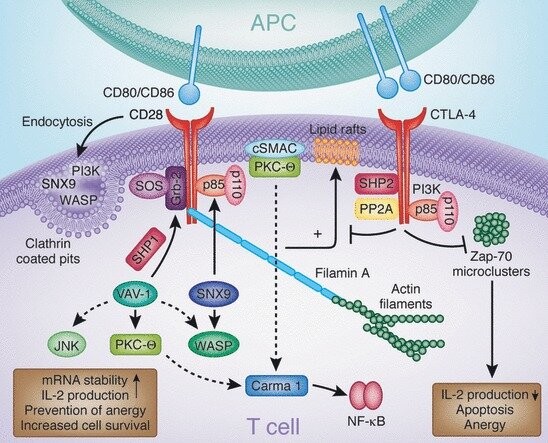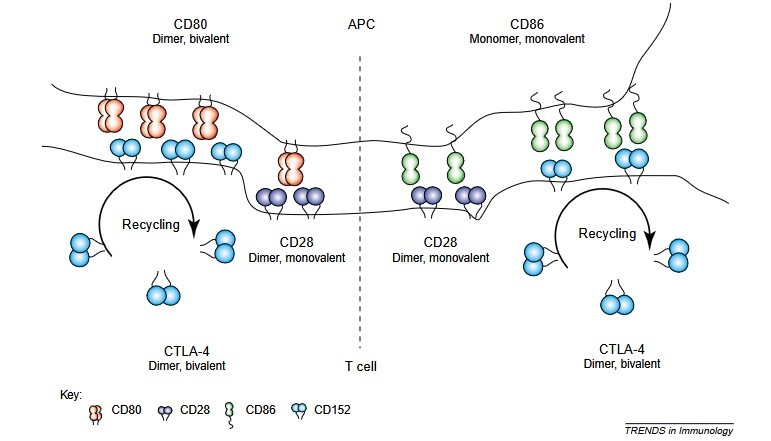| Catalog# | Product Name | Size | Price | Qty | Inquiry |
|---|---|---|---|---|---|
| THP-0102 | Belatacept, Recombinant human CTLA4 protein, Fc tagged | 5mg | $1,000.00 |
|
Add to Cart Order |
| THP-0109 | Abatacept, Recombinant human CTLA4, Fc tagged | 5mg | $1,000.00 |
|
Add to Cart Order |
CD86 (B7-2), a key costimulatory molecule in the immune system, plays a critical role in T cell activation and immune regulation. As a ligand for CD28 and CTLA-4, CD86 modulates immune responses, making it an important therapeutic target in autoimmune diseases, cancer and transplantation.
The immune system is tightly regulated to maintain a balance between immune activation and tolerance. Costimulatory molecules such as CD86 play an essential role in shaping immune responses by providing secondary signals to T cells. CD86 is expressed primarily on antigen-presenting cells (APCs), including dendritic cells, macrophages and B cells. It interacts with CD28 to promote T cell activation and proliferation, while its interaction with cytotoxic T lymphocyte-associated protein 4 (CTLA-4) leads to immune suppression.
Because of its dual role in immune regulation, CD86 has emerged as a promising drug target for modulating immune responses. In autoimmune diseases, excessive CD86 activation can exacerbate inflammation, whereas in cancer, its blockade can enhance antitumor immunity.
NCBI Gene ID: 942
UniProtKB ID: P42081
CD86 is a type I transmembrane glycoprotein of the B7 family. It consists of an extracellular domain, a transmembrane region and a short cytoplasmic tail. The extracellular domain contains two immunoglobulin-like domains, one variable (IgV) and one constant (IgC), which are essential for ligand binding. The intracellular domain of CD86 lacks significant signaling motifs, but interacts with intracellular adaptors to regulate its expression and function.
CD86 is primarily expressed on professional APCs, such as dendritic cells, B cells, and macrophages. Its expression is tightly regulated by various inflammatory signals, including cytokines like interferon-γ (IFN-γ), tumor necrosis factor-α (TNF-α), and toll-like receptor (TLR) signaling. Under normal physiological conditions, CD86 expression is low but is upregulated in response to infection, inflammation, or tissue damage.
CD86 functions by interacting with two key receptors on T cells:
 Figure 1. Signaling molecules involved in CD28
and CTLA-4 function. CD28 and CTLA-4 associate with various intracellular signaling proteins. (Rudd et al., 2009)
Figure 1. Signaling molecules involved in CD28
and CTLA-4 function. CD28 and CTLA-4 associate with various intracellular signaling proteins. (Rudd et al., 2009)
The balance between CD28 and CTLA-4 signaling determines immune responses, highlighting the importance of CD86 in immune homeostasis.
CD80 (B7-1) and CD86 (B7-2) are both costimulatory molecules belonging to the B7 family and play crucial roles in immune regulation by interacting with CD28 and CTLA-4 on T cells. Despite their similarities, they have distinct structural, functional, and regulatory differences:
| CD80 | CD80 | |
|---|---|---|
| Expression and Regulation | CD80 is inducibly expressed on antigen-presenting cells (APCs) such as dendritic cells, macrophages, and B cells, primarily after immune activation (e.g., exposure to inflammatory cytokines or pathogens). | CD86 is constitutively expressed at low levels on APCs and can be upregulated rapidly in response to immune stimuli. |
| Binding Affinities and Functions | CD80 has a higher affinity for CTLA-4 than for CD28, making it more effective in delivering inhibitory signals when CTLA-4 is engaged. | CD86 has a higher affinity for CD28 than for CTLA-4, making it more effective in providing activation signals to T cells. |
| Role in Immune Responses | CD80 is associated with later-stage immune responses, primarily reinforcing T-cell activation after prolonged exposure to antigens. | CD86 is more involved in the early-phase activation of naïve T cells, promoting rapid immune responses. |
| Structural Differences | Both CD80 and CD86 have immunoglobulin-like extracellular domains, and CD80 forms dimers that enhance its ability to cluster receptors and promote strong signaling. | CD86, in contrast, remains mostly monomeric. |
| Functional Implications in Therapy | CD80 is more involved in immune suppression, given its stronger binding to CTLA-4, making it a key target in cancer immunotherapy. | CD86 is a primary driver of immune activation, making it an important target in autoimmune diseases and transplantation medicine. |
 Figure 2. Interactions between CD80, CD86, CD28
and CD152. CD80 and CD86 expressed by antigen-presenting cells (APCs) have different structural organizations. CD80 is a bivalent dimer (two binding sites)
and CD86 is a monomer (single binding site). CD152 is also a bivalent dimer (two binding sites) whereas CD28 is a monovalent (single binding site) dimer.
Based on the differential affinities of these interactions, it can be argued that CD80 interactions favor CD152 whereas CD86 interactions are biased towards
CD28. The recycling of CD152 at the cell membrane could also affect ligand interactions. Abbreviations: APC, antigen-presenting cell; CTLA-4, cytotoxic
T-lymphocyte antigen-4. (Sansom et al., 2003)
Figure 2. Interactions between CD80, CD86, CD28
and CD152. CD80 and CD86 expressed by antigen-presenting cells (APCs) have different structural organizations. CD80 is a bivalent dimer (two binding sites)
and CD86 is a monomer (single binding site). CD152 is also a bivalent dimer (two binding sites) whereas CD28 is a monovalent (single binding site) dimer.
Based on the differential affinities of these interactions, it can be argued that CD80 interactions favor CD152 whereas CD86 interactions are biased towards
CD28. The recycling of CD152 at the cell membrane could also affect ligand interactions. Abbreviations: APC, antigen-presenting cell; CTLA-4, cytotoxic
T-lymphocyte antigen-4. (Sansom et al., 2003)
Given its central role in immune regulation, CD86 is an attractive therapeutic target for multiple diseases, including autoimmunity, cancer, and transplantation.
In autoimmune disorders such as rheumatoid arthritis (RA), systemic lupus erythematosus (SLE), and multiple sclerosis (MS), excessive CD86 signaling leads to aberrant T-cell activation and chronic inflammation. Blocking CD86 can help restore immune balance by suppressing autoreactive T cells.
In the tumor microenvironment, CD86 plays a complex role. While CD86-CD28 signaling can enhance antitumor immunity by stimulating T cells, tumor cells often exploit CTLA-4 signaling to suppress immune responses. Targeting CD86 can be an effective strategy to boost antitumor immunity.
In organ transplantation, immune rejection is a major challenge. CD86 blockade can prevent T-cell activation and reduce graft rejection.
Creative BioMart offers high-quality therapeutic proteins, including ocriplasmin, becaplermin, and ipilimumab, contact us with any questions or inquiries.
References
For more information on how our products could help advance your project, please contact us.
ENTER YOUR EMAIL HERE TO SUBSCRIBE.
Copyright © 2025 Creative BioMart. All Rights Reserved.